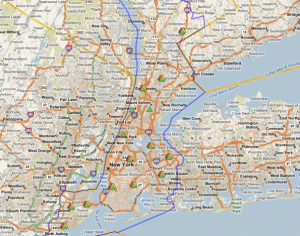WSI, a Weather Channel company, expects most of the U.S. to be, on average, warmer than it has been over the past 30 years. This forecast for prolonged heat suggests both increased energy usage and an even more active hurricane season. “A new La Nina event continues to rapidly evolve as we head deeper into summer. This will favor more heat across the northern US as the summer progresses,” said WSI Chief Meteorologist Dr. Todd Crawford. “In the Atlantic, record warm ocean temperatures also favor warmer-than-normal temperatures across a majority of the US. On the other hand, near-record soil moisture levels across parts of the central and northern Plains, along with a lack of any significant drought conditions in the US, will temper the overall magnitude of the heat. By early July, we expect heat to spread across most of the western US and to persist across the Southeast, while relatively cooler temperatures persist across the north-central and northeastern US. By August and September, we expect the heat to become more widespread across the northern US. For the July-September period as a whole, we are forecasting 836 population-weighted cooling degree days, 7-8% more than last year and about 10% more than the 1971-2000 mean.” Many of us will be revising our budgets for the second half of the year as air conditioning proves to be a larger line item than expected.
Archive for the ‘Heat Wave’ Category
Continuing Heat Wave Results in Higher Energy Bills
Wednesday, July 14th, 2010Heat Wave Saps New York City
Friday, July 9th, 2010With temperatures soaring past 100 degrees, residents of New York City are seeking the shade. Heat wave is the leading cause of weather-related deaths. The current wave has already caused two fatalities. The elderly and the medically vulnerable are most at risk for dehydration and heat stroke. This map shows power outages reported by ConEdison owing to peak demands on the grid from air conditioning systems. To discourage excessive utilization, city inspectors are assessing fines for retail businesses that leave their doors open and blast the air conditioning, to encourage shoppers to come in and cool off. If your business is one where telecommuting is feasible, a heat wave is a good time for people to work from home. Even if your office is located in an area with a reliable power supply, employees still have to commute to and from work where they may be exposed to excessive heat and humidity. Consider your clients and vendors at this time and if you can re-schedule their visits to your office until after the heat breaks, do so. They will appreciate your sensitivity to their well being and comfort.
A Disastrous Weekend
Sunday, June 20th, 2010The weekend began with a series of giant tornadoes tearing through Minnesota, destroying buildings and causing at least three deaths. The National Weather Service received 36 reports of tornado sightings which, if all are confirmed, would exceed the previous record of 27 tornadoes striking Minnesota in a single day, back in 1992.
Estimates of the volume of oil leaking each day into the Gulf of Mexico were revised upward as more information about the extent of the rig damage came to light. More Gulf Coast tourism and fishing businesses closed as a consequence of the environmental damage. USA Today published an excellent article about the disaster fatigue suffered by Gulf Coast residents who are “forever in recovery” as Katrina-inflicted damage is still with them even as they face the consequences of the oil spill.
The southern states experienced an extreme heat wave, with temperatures in the high 90s/100s. And summer doesn’t officially begin until tomorrow! We are in for a tough weather season. To get you thinking about updating your disaster recovery plan, check out the following article by Inc. magazine columnist Donna Fenn.
Flooding in Kentucky, Drought in Texas
Thursday, August 6th, 2009Louisville, Kentucky was flooded when a storm left the area with more than seven inches of rain, resulting in flash flooding, and power outages. Thankfully, no casualties or serious injuries resulted from the storm, but the rainfall overwhelmed the area’s public infrastructure and caused major disruptions to local small businesses. The mayor of Louisville estimates that the main library sustained $1 million in damages when flooding destroyed books. Firemen led water rescue efforts for people stranded as animal shelters evacuated animals to minimize casualties due to drowning.
At the same time, Texas is experiencing a severe drought with 100-degree temperatures in an area that includes Austin, Dallas, Houston and San Antonio. As a result, mandatory water restrictions have been imposed on 230 Texas public water systems, which prohibit practices such as watering lawns or refilling swimming pools. It bears repeating; prepare for the more frequent disasters, such as drought and flash flooding, as such measures will yield a more immediate benefit against a more imminent threat at more reasonable cost.
Back to Phoenix
Thursday, September 11th, 2008Today, I participated in a radio interview with Ken Morgan and Julie Dougherty, the hosts of Business for Lunch, a program of Phoenix financial news radio station KFNN-AM. As we considered the needs of Phoenix small businesses, I shared with the hosts and their listeners that I had recently returned from Phoenix, the site of the 2008 annual conference of the National Association of Women Business Owners. Together with Erin Streeter of the Department of Homeland Security, I taught a workshop on helping NAWBO members prepare for the worst and plan for the best. Phoenix is blessed by geography, so it is easy to become complacent. But while in Phoenix, I learned of a business that learned the hard way to look beyond the obvious. This was a manufacturer of skin care products that relied on a sole supplier for a critical ingredient. That supplier was under eight feet of water in Iowa owing to the severe floods in the mid-western states. Although she was not directly affected by the disaster, she was indirectly affected – and may lose her business.
What could she have done differently? Her first step should have been to try to diversity her supplier base so she would not be critically dependent on a single supplier. I have, for example, all of my graphics files for letterhead, business cards and other marketing collateral with a printer in Sacramento. When my local printer could not deliver, I called Sacramento and implemented my backup plan. If this ingredient was so rare that she could not have found an alternate supplier, she should have sought contingent business interruption insurance to protect her business against this risk. I suspect that the cost of this additional coverage would have been relatively low.
Ken, Julie and I then talked about the issues around heat waves, a major risk in Phoenix. Did you know that heat waves cause more fatalities than any other natural disaster? If this is a risk for your business, be sensitive to the special medical needs of more vulnerable employees, customers or suppliers. Re-schedule your meetings with them when the temperatures will cool down or encourage telecommuting.
While in Phoenix, I also visited the team at the W.P. Carey School of Business of Arizona State University, who were kind enough to review the book. I look forward to returning to Phoenix. My radio interview with Ken and Julie was a nice break from what was otherwise a somber memorial date.



